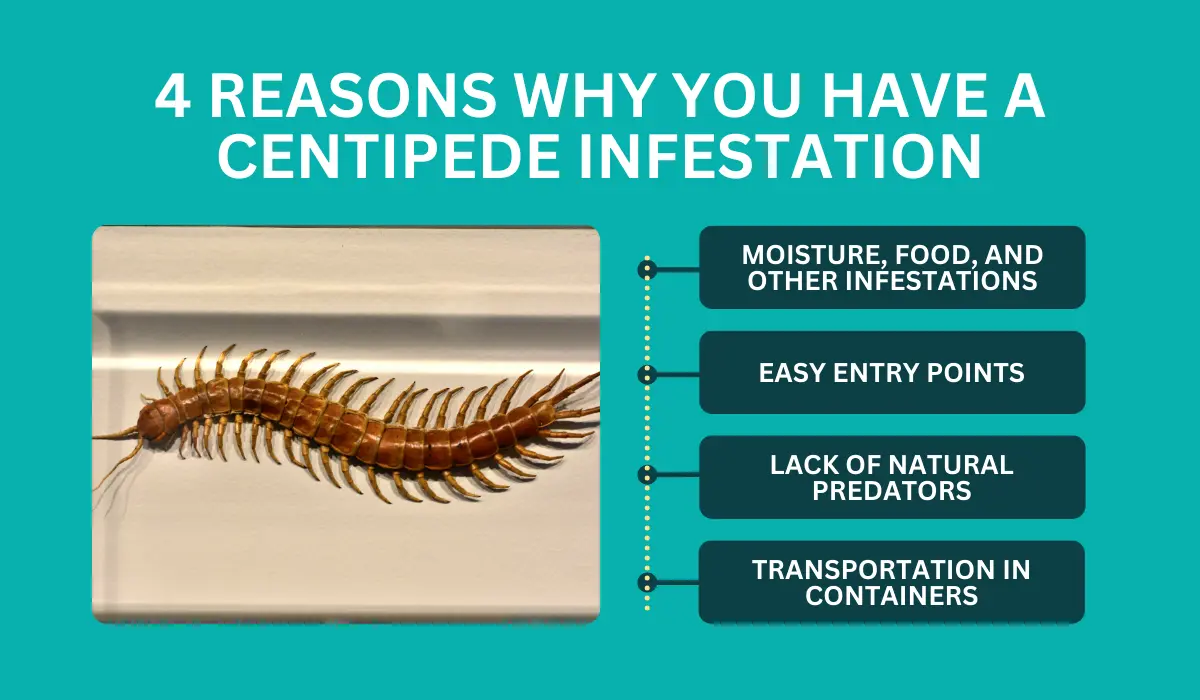Why Are There So Many Centipedes in Your House?
Discovering centipedes in your home can be unsettling. These swift, multi-legged pests often appear in damp areas like bathrooms and basements, hinting at issues like excess moisture or other small pests they feed on.
Could certain aspects of your home be inviting them in? Keep reading to know what makes your space attractive to these unwelcome guests.
Key Takeaways
- Understanding that centipedes are attracted to homes due to moisture, food availability, accessible entry points, and absence of predators can help you target your prevention strategies.
- Employing natural remedies and considering commercial products may effectively control centipede presence in your home.
- Keeping your home dry, clutter-free, regularly cleaned, and sealing entry points are essential to preventing centipede infestations.
- If the infestation is severe, professional pest control can provide a comprehensive approach, utilizing expert assessment and specialized tools to tackle the problem and prevent future issues.
4 Reasons Why You Have a Centipede Infestation

House centipedes are drawn to homes for various reasons. So, understand these factors to learn how to prevent and tackle infestations effectively.
1. Moisture, Food, and Other Infestations
Homes with moist areas provide ideal conditions for centipedes and millipedes. Specifically, these indoor conditions attract them:
Indoor Conditions | Attraction for Centipedes |
High Moisture | Damp areas, such as crawl spaces, sustain their hydration |
Food Sources | |
Infestations | Other household pest infestations (cockroaches, silverfish) signal a stable food source |
2. Easy Entry Points
A home with unsealed entry points can inadvertently invite centipedes indoors. So, take note of the typical entry points for these arthropods:
- Crevices and Cracks: Openings in foundation walls and around windows.
- Unsealed Gaps: Spaces under doors or around pipes entering the house.
- Floor Drains: Often overlooked, these can grant access from subterranean levels.
- Poorly Fitted Baseboards: Offer direct entry from wall voids and adjacent rooms.
3. Lack of Natural Predators
Centipedes thrive in homes lacking their natural enemies since these predators are crucial in controlling their populations.
While you can’t invite them inside the home, having them at a safe distance outdoors can deter these creepy crawlies. Here’s how you might encourage them:
Natural Predators | Encouragement Tips |
Spiders | Allow harmless spiders to reside in less-frequented corners |
Birds | Place bird feeders to attract insect-eating birds |
Frogs | Maintain a garden pond to support a healthy frog population |
4. Other Potential Factors (Less Common)
There are also rare causes for a house centipede infestation. A couple of these factors include:
- Transportation in Containers: Centipedes hiding in cardboard boxes and indoor plants might be brought inside.
- Indoor Breeding: Rarely, species of centipedes might establish a breeding area in secluded parts of the home, such as rarely disturbed closets or attics.
How to Get Rid of Centipedes
When you notice a house centipede problem in your home, it's crucial to act swiftly. These critters can multiply and move fast with their scurrying movements and numerous long legs.
Before taking action, confirm you're dealing with centipedes. As homeowners, here are some key features you should remember:
- Body: Elongated body with numerous long legs (15 pairs of legs or more)
- Legs: Legs increase in length towards the back
- Antennae: Possess a set of antennae
Natural Home Remedies
Safe and effective home remedies can be employed before contacting pest control services. Here's how you can use them in centipede control:
Natural Remedy | Application |
Apply along baseboards and crevices | |
DIY Sticky Traps | Monitor and replace as needed |
Essential Oils (Peppermint) | Spray in affected areas |
Spray in nooks favored by centipedes |
When dealing with centipedes in your home, consider these commercial products to manage the issue effectively:
Insecticides: Always follow the manufacturer's instructions to prevent accidental exposure, which could lead to an allergic reaction.
Baits and Traps: Various traps can efficiently capture centipedes without spreading chemicals around your home.
How to Prevent Future Infestations
Effective prevention of future centipede infestations hinges on creating an inhospitable environment for these many-legged intruders.
To keep centipedes out of your home, it is essential to keep it clutter-free and regularly cleaned. So, always keep tabs on these focus areas:
Focus Areas | Preventive Measures |
Seal Entrances | Caulk cracks, fix screens |
Reduce Moisture | Use dehumidifiers, fix leaks |
Remove Clutter | Declutter regularly |
Cleaning Routine | Sweep, vacuum, and mop |
Source of Food | Eliminate other pests |
Bathrooms & Basements | Seal drains, reduce dampness in bathtubs |
Should You Get In Touch with Pest Control Professionals Now?
If you've swept a centipede here and there under the rug, but now they're turning up in droves, it's not just a lone wanderer anymore. They're enjoying a full-on house party at your expense.
So when your home becomes a haven for centipedes, it's the right time to call in the exterminators—a professional pest control company (like us at Native Pest Management).
We won't just eradicate these uninvited guests but also advise on household changes to deter future invasions.
